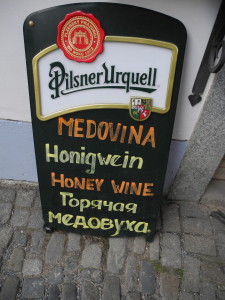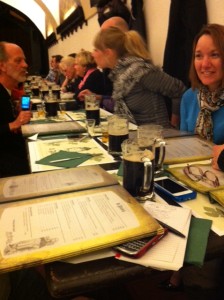When you think of European beer, Germany may spring first to mind, but the real capital is the Czech Republic.
Czechs are said to drink more brew than any other nationality in the world: 40 gallons annually for every man, woman and child in the country. I’m guessing that the average is somewhat higher than that for adult men.
The very word “pilsner” derives from the city of Pilsen in the Czech Republic, where the country’s best known export — and my longtime favorite beer, Pilsner Urquell — is brewed. It was the first golden pilsner ever made.
On my recent Insight Vacations tour of Prague, I discovered that Pilsner Urquell is only the beginning of what Czech beer has to offer.
Along with 30 other journalists from around the world, I was fortunate to join the Insight Vacations group as we hit two of the more interesting breweries in the Czech capital, Prague.
Our first night in Prague, we visited the Monastic Brewery (Klasterni Pivovar Strahov) and Restaurant St. Norbert, situated in the Strahov Monastery area on a hillside overlooking almost all of the city. Monks at the monastery, which was established in 1142 by King Vladislav II, started brewing beer by the year 1400, although the current brewery dates from 2001 and isn’t run by monks.
We were served both amber and dark lager, along with a huge selection of cold cuts, salads and dips, and we also got a sampling of the bittersweet Czech liqueur Becherovka, which is clearly an acquired taste. The beer went down very smoothly, though.
In the true Czech tradition of eating perhaps more than one should, we then went to dinner at the nearby Peklo (“Hell”) restaurant, located in a wine cellar below the monastery. The buffet meal included salads, roast beef, and some of the best smoked salmon I’ve ever had. (The Irish journalist sitting across from me guessed it was from Ireland.) In keeping with the wine cellar theme, however, we were served wine rather than beer.
The following night we made up for that omission at Prague’s oldest beer hall, U Fleku, set in a building that dates from 1499. It’s located in Prague’s New Town, which is actually very old (14th century), though not as old as Prague’s Old Town (10th century).
The layout — eight different “lounges” or beer halls and a beer garden — is somewhat confusing, especially after downing a few of U Fleku’s signature dark beers, brewed on the premises. Judging by the amount consumed at our tables, it was a hit.
Each lounge is huge, equipped with dozens of long wooden tables, and patronized by both Czechs and tourists seeking to keep up with their annual beer allotment. The rooms are all different in design, including an “Ancient Czech Hall,” a “Cabaret Hall,” and a “Sausage.” Alas, I didn’t get a chance to check out the Sausage room.
But the Sausage room — or any of them, for that matter — can definitely get you in the mood for eating, and U Fleku provides plenty of traditional Czech food to soak up the brews. You can choose among typical dishes like roasted sausages (of course), smoked pork neck, garlic soup, goulash, roast duck, sauerkraut, red cabbage, bread dumplings, potato dumplings (the Czechs love their dumplings), potato pancakes, and, as everywhere in Central Europe, apple strudel.
I always went by the philosophy that you can’t go wrong with goulash, though it was tempting to try the pork neck, and, another popular item, pork knee. There is no dearth of pork in the Czech Republic.
One oddity about Czech restaurant menus is that they list the weight in grams of all the meat dishes and, frequently, also the side dishes. Common meat weights are 200 grams (seven-plus ounces) and 400 grams (nearly a pound). I usually stuck to the 200-gram sizes, especially if I was downing heaps of dumplings and potato pancakes on the side. Cabbage seems to be the prevailing vegetable.
But the brewed-on-the-premises dark beer was the hit of the night. That and the accordion player who would periodically appear, always with a big smile as he serenaded us with lively beer hall tunes.
U Fleku also has a Brewery Museum that’s open weekdays during the day and groups of 10 or more who eat at U Fleku can also arrange brewery tours, which includes beer tastings. But the next morning we were off to the medieval village of Cesky Krumlov in the southern part of the Czech Republic, where we were to be treated to more of Insight Vacations “Signature Experiences” — activities that standard tours simply don’t offer — and, oh yes, more Czech beer.
Next up: Cesky Krumlov.














2 Responses to A Beer Lover’s Tour of Prague